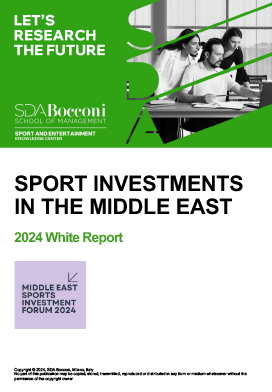
- Start date
- Duration
- Format
- Language
- 16 sep 2025
- 40 hours
- Online
- Italian
Offer sports organizations know-how, rationales and tools to support and “professionalize” management and managerial activities.
Events such as the FIFA World Cup in Qatar (2022) and Saudi Arabia (2034) are declarations of strategic ambition. They serve as tools to reposition the Middle East on the global geopolitical landscape, as the region seeks an identity that goes beyond oil. Sporting events, therefore, act as catalysts for unprecedented economic diversification.
This evolution is no coincidence. Instead, it is the result of carefully planned strategies and long-term outlooks, such as Qatar’s and Saudi Arabia’s Vision 2030 and Oman’s Vision 2040. Sports investments extend beyond stadiums and events; they aim to enhance quality of life, social cohesion, and tourism, according to the MESIF White Report, a strategic document produced by the Sport and Entertainment Knowledge Center at SDA Bocconi School of Management for the Middle East Sports Investment Forum (MESIF).
The report explores the phenomenon of sports investments in the Middle East, analyzing how they are redefining sports as economic and social drivers. Before this transformation, the region was perceived as peripheral in global sports, with limited involvement beyond occasional events and a few world-class infrastructures.
Three questions guide the report:
The report, which combines quantitative data, case studies, and interviews with experts, illustrates how the Middle East has moved from being a peripheral player to a central protagonist in international sports.
The market is experiencing rapid growth, rewarding the diverse strategies of the most engaged countries. Qatar, leveraging its FIFA World Cup 2022 experience, expects its sports sector to be valued at $3.7 billion by 2025. Saudi Arabia aims for sports to contribute 3% of its GDP by 2030, generating 100,000 jobs. This nation also aspires to become a hub for international events, with 15 stadiums designed to host global competitions. Oman has adopted a regional approach, focusing on niche events such as kiteboarding and sailing, which enhance its natural landscape and attract a selective audience.
Building cutting-edge infrastructure, coordinating efforts in talent scouting, establishing sports academies, and diversifying events: all these efforts enable the region to compete with traditional sports powerhouses across multiple fronts, from football to emerging disciplines.
One of the most significant impacts of this strategy is economic. These investments are creating jobs, opening opportunities for local and international businesses, and setting new benchmarks for other nations. In fact, the level of sports infrastructure in Qatar and Saudi Arabia is already (or soon will be) on par with or even surpassing that of many Western countries.
Sports in the Middle East are emerging as a sector capable of generating tangible impacts across multiple areas:
On the research front, new avenues are opening up to study the social impact of sports investments and the long-term economic returns. What’s more, education plays a crucial role in facilitating dialogue and connections between the Middle East and the rest of the world, fostering two-way exchanges.
The Middle East is positioning itself as an open-air laboratory to understand how sports can evolve from mere entertainment into a strategic tool for nation branding - a model that not only contributes to global knowledge but also offers valuable lessons in economic and social development through sports.
 |
RUTA D., BIGOTTO C. |